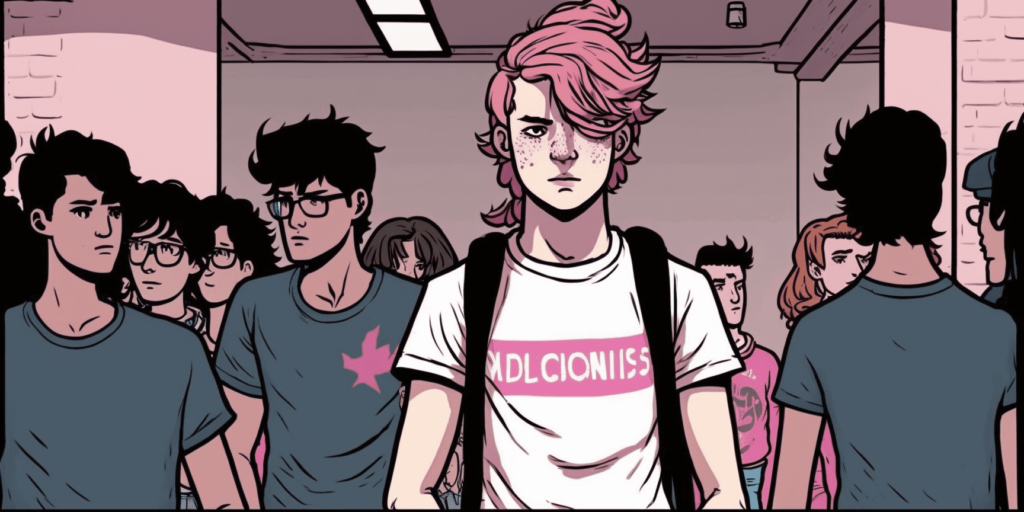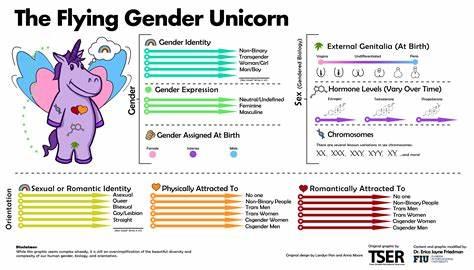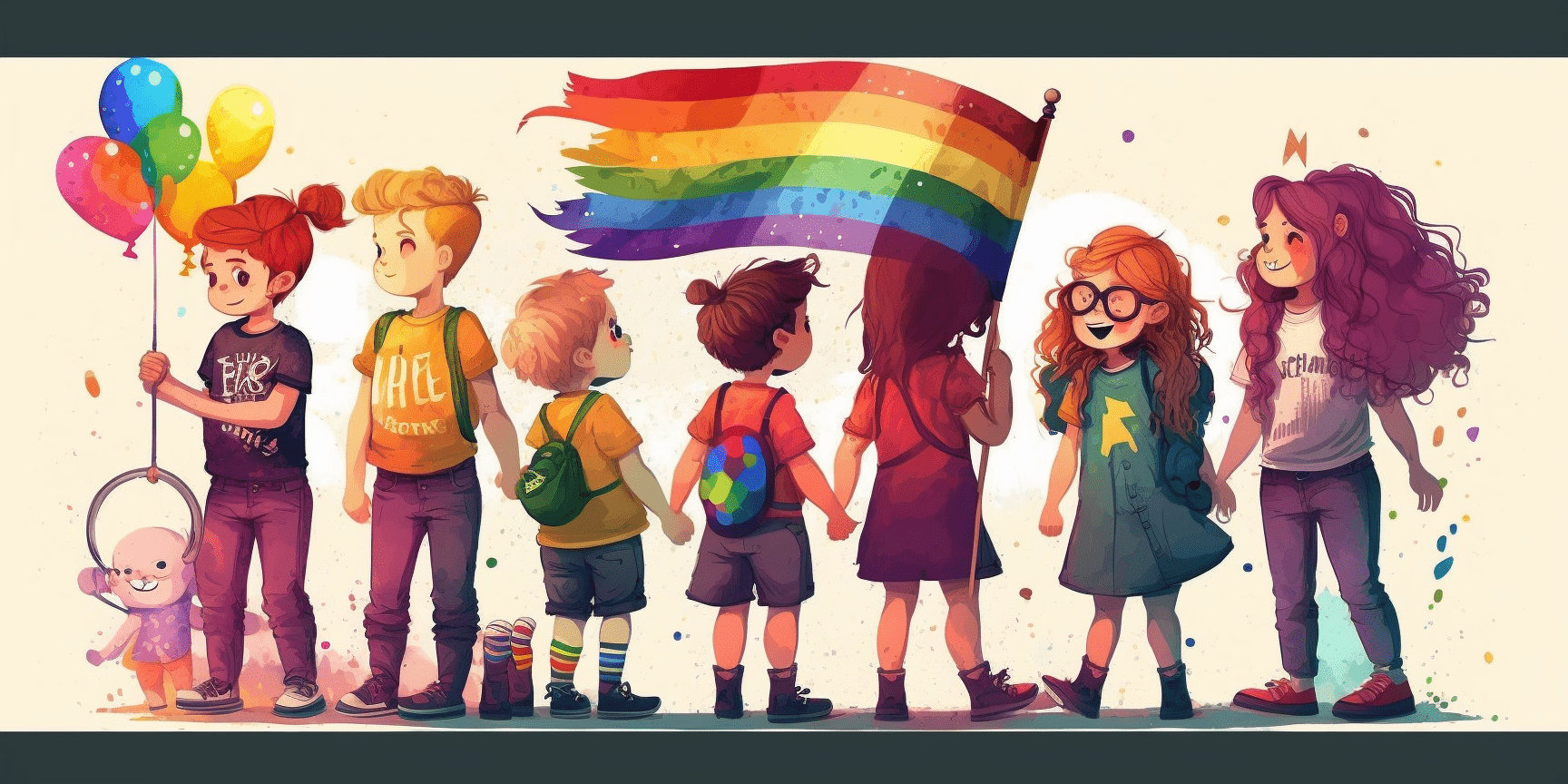5.2. IGNORING GENDER IDENTITY ISSUES

- Gender is a social construct while the gender identity is the person’s feeling of belonging to one (or none) of the gender categories.
- Gender identity is not the same with gender expression.
- Heteronormativity is not the only valid option.
- It is normal and important to question your gender identity.
- Ignoring gender identity issues can lead to potential harm/suicide.
5.2.1. INTRODUCTION
The WHO (2022) describes gender as something that refers to the characteristics of women, men, girls, and boys. This includes norms, behaviours and roles that are associated with being a woman, man, girl, or boy. All of these characteristics are socially constructed, which means that they can differ between different cultures, in different geographical locations and they can also change in time. However, gender does not mean only men and women, but is rather represented as a spectrum full of different options such as agender, non-binary, etc. Discovering your gender identity is a process, just like discovering your sexuality.
5.2.2. DEVELOPMENT OF THE TOPIC
A starting point can be represented by the Gender Flying Unicorn, depicted in Figure 5. This figure summarises the differences between biological sex, gender, and attraction.

Figure 5. The Flying Gender Unicorn
Trans Student Educational Resources (TSER), 2015 & PhD. Erica Jayne Friedman
When talking about gender identity it is necessary to clarify a few terms that are often associated with the identity of the person. These terms are gender identity, gender expression and gender assigned at birth. Even though these three terms can be connected to each other in some cases (for example a person who was assigned female at birth can have a feminine gender expression – choices of clothes, hairstyle, etc.) there are cases where they do not have that connection (for example a person who was assigned male at birth can identify as a non-binary person and have a feminine gender expression). Because of the heteronormative mentality that is widespread in our society, most of the people got used to the gender binary – male & female – and to the assumption that the gender assigned at birth should correspond with the gender identity and gender expression of the person in question. In order to deconstruct this and to be mindful about the diversity that is surrounding us, we need to clarify a few of these terms.
5.2.2.1. What is the difference between gender and sex?
Sex refers to the biological aspects concerning masculinity and femininity. When people are born, they get assigned a certain sex based on their physical body characteristics. Intersex people are born with physical characteristics that are associated with both sexes. In some countries they can be assigned as intersex, while in other doctors may perform gender assignment surgery on babies by removing certain physical body parts leaving thus the ones assigned to only one of the binary sexes.
5.2.2.2. Gender identities
The gender that a person is assigned at birth does not necessarily match the gender this person identifies with. The personal sense of belonging to one (or none) of the gender categories is called the gender identity of this person. A person that is assigned female at birth can, for example, feel that they belong to the gender category of men or any other gender from the infinity of the options on the gender spectrum. Not identifying with the gender, you were assigned at birth, is called gender dysphoria (Psych Central, 2022).
If a person identifies with the gender they were assigned at birth, they are considered cisgendered. If the gender that was assigned to them does not fit with their gender identity, they are considered transgendered, as they are “changing” the gender that they were assigned or that is expected from them to fulfil. There are many different forms and ways people identify and this should always be considered when working with people.
While a person can identify as a man, a woman, or any other gender, they can also move between these in a fluid way. We call this gender fluidity. A gender fluid person identifies with more genders and fluctuates between those, as they do not feel like they could completely fit into one of the gender boxes.
A person who does not feel like they belong in any of these categories can identify as non-binary.
Both sex and gender are represented on a spectrum. People can be or feel more or less feminine or masculine and can express this in a variety of ways.
Developing your personal gender and/or sexual identity can be a long process that will require self-awareness, repression, and acceptance. It is linked to developing an intimacy, exploring different options, and finding a community that can support you during this journey. It may also include sharing your personal identity with friends and family, making this a sensitive process that places the person who is sharing/exploring into a vulnerable position.
You can read more about gender identity on the topic 2.1.
5.2.2.3. Gender expression
Gender expression refers to the way people express themselves through clothing, the use of make-up, the haircut they have, etc. Throughout history, societies have linked certain ways of dressing, hairstyling or wearing accessories to a specific gender. For example, make-up or wearing a lot of jewellery is associated with women, short hair is associated with men. Nowadays, people are questioning these standards more and more, normalising different kinds of gender expression. The most common example would be for someone who identifies as a male to wear a dress or make-up, because their gender expression does not have to be linked to stereotypical expectations of their gender identity.
You can read more about gender expression on the topic 2.2
5.2.2.4. Gender roles
A big component of gender is the roles that society has linked to them. For a long time, care work (cleaning, cooking, taking care of children or elderly people etc.) was considered a ‘woman’s job’ and men were expected to be responsible for bringing money into the house. Although these perceptions are changing, gender roles are deeply rooted in our society and in ourselves and it is important to be aware of the expectations we have and the different roles we assign to people (for example when delegating tasks).
Being sensitive to our personal gender expectations and giving everyone the same tasks and responsibilities when working with them, are a few things that can help us navigate the issues of gender roles. In this way, everyone can contribute to everything and there won’t be a certain expectation that a specific gender has to fulfil certain tasks (ex. women have to cook). Gender roles are also connected to gender identities considering that once you have a certain gender identity assigned, you are also expected to fulfil a specific role and to present yourself to the world in a specific way. Apart from being a practice rooted in patriarchy, assigning gender roles (that are also based on the gender binary and automatically reject other genders) can cause gender identity issues within oneself or in the people you are working with.
You can read more about gender roles on the topic 9.3.
5.2.2.5. Heteronormativity
Heteronormativity is the concept that describes heterosexuality as the norm in our society. It assumes everyone’s heterosexuality and the gender binary (man or woman). This assumption also comes with expectations related to gender expression, task distribution, social position, etc.
We tend to look at the world in a heteronormative way. For example, in most of our stories, films, series, a heterosexual orientation is depicted. Princes marry princesses and children have a mother and a father. We see heterosexuality as ‘the norm’ and heterosexual people are considered ‘straight’. In youth work we should be sensitive to this and do our best to include everything that doesn’t fit this ‘standard’ in our work. There are lots of other sexual orientations and we should be aware of them all. People can identify as homosexual, lesbian or bisexual, but also as pansexual (attracted to all genders), asexual (not sexually attracted to anyone) or any other sexuality on the spectrum. Some people are romantically attracted to one gender and physically attracted to a different gender.
You can read more about heteronormativity on the topic 2.3.
5.2.2.6. What happens if you ignore gender identity issues
Many activists and organisations working towards making gender diversity visible, are stating that most of the problems people with gender dysphoria or a different gender identity encounter are not due to their identity but rather due to the problems that arise from dealing with the social problems that come with it. Among this, bullying (mental and emotional), depression, anxiety and substance abuse are some of the most common effects of ignoring someone’s gender identity (Psychologist Anywhere Anytime, 2019).
When you’re ignoring someone’s gender identity, you are telling them that they do not exist. That the version they feel is themselves and that they want to present to the world is not valid because it does not fit into one of the binary boxes we were taught about or the box that they were assigned at birth. This often leads to reducing social contact or even isolation based on the social rejection that is encountered.
5.2.3. BEST PRACTICES

Discrimination cases and dealing with gender identity issues can be very complex. Here are some practices that can be helpful:
5.2.3.1. Educate yourself
Read on the topic of gender identity and inform yourself about the different aspects, dimensions and possibilities that exist. The best sources are often the ones created by the people who are going through the situation you’re analysing. So, if you would like to know more about gender identities, it would be advisable to read articles/blogs/books written and designed by people who do not conform with the gender binary. These can be for example queer/non-binary/agender/genderfluid people, just to mention a few.
By educating yourself you are also helping in educating other people. Opening up the conversation, questioning the gender binary or the idea that there are only certain gender identities that are ‘valid’ and that they have to match with a specific sex are only a few things that can help in making the problem visible and educating people about it.
5.2.3.2. Ask instead of assuming
When meeting a new person, you can always ask for their pronouns or for how they identify so you can avoid misgendering them. It is really common to assume people’s gender identity instead of asking and this can lead to miscommunication, uncomfortable moments, and even more serious problems if it is a recurring situation (for example mental health problems for the person not conforming with the gender binary).
5.2.3.3. Lead by example
By following the first two practices you are already leading by example. Regardless if you are conforming or not with the gender binary, being aware of the social constructs and the spectrum of an infinity of genders is already making a difference for the people who are either questioning their gender identity or not conforming with the identity they are expected to fulfil.
Simple acts such as keeping yourself informed and introducing yourself with your pronouns when you meet somebody new are already taking us a step closer to normalising this for others.
5.2.4. REFERENCES
Psych Central (2022). Sex vs. Gender: What’s the Difference and Why Does it Matter? Retrieved from https://psychcentral.com/health/sex-vs-gender#identity-vs-expression.
WHO (2022). Gender. Retrieved from Gender (who.int).






